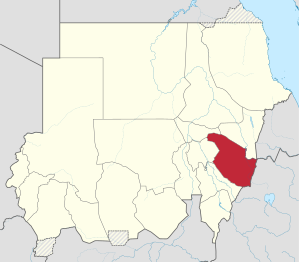Al Qadarif (state)
|
Al Qadarif القضارف Gadaref, Gadarif or Qadārif |
|
|---|---|
| State | |
 Location in Sudan. |
|
| Coordinates: 14°0′N 35°0′E / 14.000°N 35.000°ECoordinates: 14°0′N 35°0′E / 14.000°N 35.000°E | |
| Country |
|
| Region | Kassala Region |
| Capital | Al Qadarif |
| Government | |
| • Governor | Mergani Salah Seed Ahmed |
| Area | |
| • Total | 75,263 km2 (29,059 sq mi) |
| Population (2006 (est.)) | |
| • Total | 1,369,300 |
| Time zone | EAT (UTC+3) |
Al Qadarif (Arabic: القضارف Al Qaḍārif), also spelt Gadaref or Gadarif, is one of the 18 wilayat or states of Sudan. It has an area of 75,263 km² and an estimated population of approximately 1,400,000 (2000). Al Qadarif is the capital of the state; other towns include Doka and Gallabat.
Demographics
Inhabiting Gedaref State of ethnic groups inside Sudan representing different tribes, and other related assets from outside Sudan, Eritreans and Ethiopians and Yemenis, Somalis, Chadian and Egyptian Copts, Armenians, Kurds and others. This diverse social structure have been formed because of the migrations that occurred during the period of Turkish rule and the Mahdist revolution and as a result of the evolution of the mechanism which caused the state's agriculture. These groups have merged and coexisted in a multicultural society. The state is natural geographical area on the slopes of the Ethiopian plateau and descend towards the rivers, valleys and creeks loaded with water as well as enjoying the state with land of clay soil fertile and interspersed with some hills. The distinction can be made between the three geomorphic regions: High land in the south east of the state on the Sudan-Ethiopia border, as well as some mountains and hills isolated chains. Plains is characterized by mud-flat lands and simple regression, and form appearance Altobgrave mostly in the state. And valleys area dominated by land-sedimentary about seasonal rivers (the Atbara River, State, Rahad and the Islam)
Economic activity
Agriculture
The state is characterized by vast land suitable for agriculture, and the largest projects for rainfed agriculture in Sudan, a mechanism that agriculture machine used in various stages of production such as tractors and combine harvesters rely on rainfall rain, Otojd in the state silos to store grain with large capacity. It also has the largest market for private crop sesame crops, and sorghum. The state is considered important for food security in Sudan's strategic center, so agriculture is the economic activity and often rely on rain for irrigation, as well as associated with agriculture and trade, including the border with Ethiopia and Eritrea trade in services. With the introduction of the machine in agriculture in 1945 expanded the agricultural area until it reached 71,621,33 kilometers, while armed amounted to 2376563 forest five kilometers and contribute to the production of gum arabic from Sudan. The distribution of agricultural areas on the following areas: Belt dry Agriculture: is approximately 1.62792 million acres and is located in the north of line with rates ranging between 500 and 600 mm rain zone. Featuring Ptrepettha mud and lack of valleys and creeks and practiced mechanized farming in the form of a large sprawling fields. Belt rainfed agriculture: the area of about 2,962.620 acres and range from a rainfall of 550 to 600 mm, the type of clay soil and permeate the home coves flat plains Mmaaada part adjacent to the River Rahad where it is exposed to Vidhanat.autamars where rain-fed agriculture in the form of large fields and other small about Alqryz and there are forests Reserve. Water basins area: The area of about 1.58034 million acres, and permeate its soil Gedaref Hills series (tippers, gouge bees and Mount QNA) where water descends towards the clay soil land and water available. Belt and mixed farming area of about 1.3924 million acres. Protected areas: The total land area of about 176 630 acres Watershed protected waters, and an area of about 878 180 acres.
...
Wikipedia
